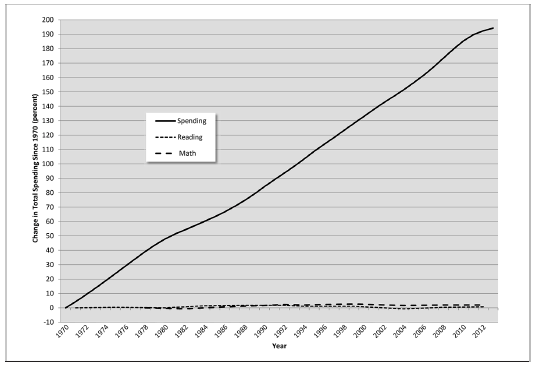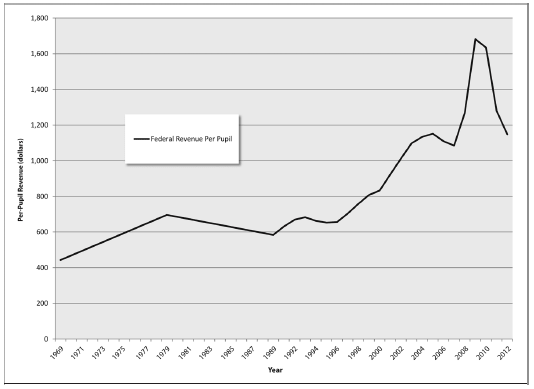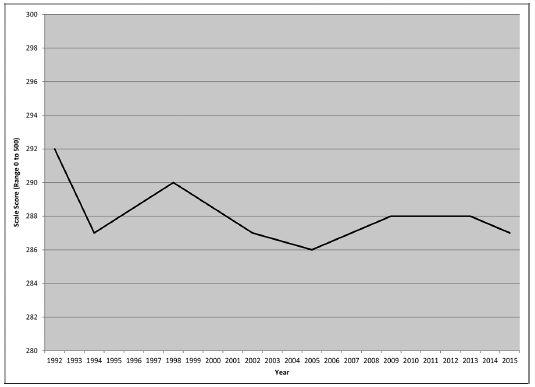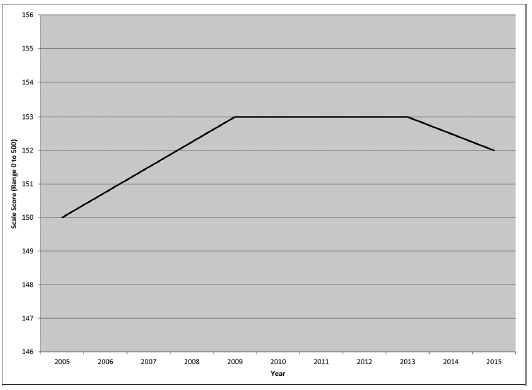Congress should
47. K‑12 Education
• continue down the path of returning power to states, districts, schools, and parents that has slowly begun with passage of the Every Student Succeeds Act;
• ultimately eliminate federal involvement in K–12 education except for supplying school choice in Washington, D.C., funding education for students in military families, and prohibiting discrimination in state and local provision of education; and
• via tax reductions, let taxpayers keep the roughly $80 billion per year that the federal government spends on K–12 education.
The Constitution gives the federal government no authority to exercise control over elementary and secondary education, including by spending money and attaching conditions to the funds, the primary mode by which Washington has influenced education. And no, the Founders did not exclude dominion over education from the specific, enumerated powers given to Washington because they thought such authority was subsumed under the "general welfare" clause. They did not include it because education at the time was believed best left in the hands of parents and civil society — the families and communities closest to the children — and certainly not in a distant, national government. Fifty years of experience with major and, until very recently, constantly expanding federal meddling in K–12 education has proven them right.
A Brief History of Federal Involvement
The federal government, relatively speaking, is a newcomer to elementary and secondary schooling. As many advocates of a federal role in education are quick to point out, the Land Ordinance of 1785 and Northwest Ordinance of 1787 did contain provisions calling for territories to dedicate the revenue coming from the sale of portions of land to educational purposes. But those laws preceded the Constitution, were often ignored, and asserted no federal control over what might be taught, how, or by whom. And clearly, James Madison, one of the primary architects of the Constitution, as well as other members of Congress, did not consider education to be among the matters rightfully within the reach of the federal government. In 1792, Madison argued against a bill to provide aid to fisheries by noting that were Congress to decide that the Constitution furnished the authority to spend money on fisheries, they could also, absurdly, "take into their own hands the education of children." Indeed, as recently as 1943, the U.S. Constitution Sesquicentennial Commission, chaired by President Franklin Delano Roosevelt, published a document that included the following: "Q. Where, in the Constitution, is there mention of education? A. There is none; education is a matter reserved for the states."
Thus, federal governance of elementary and secondary education is of relatively recent vintage. A U.S. Department of Education was created in 1867, but it was downgraded to a bureau two years later and was charged mainly with collecting statistics, not governing. Not until the Soviet Union sent the satellite Sputnik into orbit in 1957, and the American public briefly panicked, did the federal government for the first time try to exercise significant influence over education. That foray, the National Defense Education Act, primarily aimed to improve capacity in science and engineering at the college level. And the act maintained a clear connection to a constitutionally explicit federal responsibility: providing for the common defense.
Only in the mid-1960s, under President Lyndon Johnson's "Great Society," did Washington completely break with the Constitution by enacting a K–12 law untethered to national defense. The Elementary and Secondary Education Act (ESEA) was enacted in 1965 and sought, primarily, to provide "compensatory" funding to districts serving low-income populations. The intent was not to exercise authority over states and districts, but to equalize resources. What was discovered over the course of about two decades, however, was that funding alone made little difference in outcomes.
By the early 1980s, many people considered the American education system to be failing. As a result, the federal role began to morph from one focused on funding, to one focused on control — control made possible only by attaching coercive rules to federal dollars. Indeed, the Reagan administration at first strove to eliminate the cabinet-level U.S. Department of Education, which had just been re-created in 1979. But in 1983, the administration published A Nation at Risk, a report with a Sputnik-like effect. It intoned, "If an unfriendly foreign power had attempted to impose on America the mediocre educational performance that exists today, we might well have viewed it as an act of war." The administration's second education secretary, William Bennett, became a major personality to whom the media and public looked for guidance on education issues, and the 1988 reauthorization of the ESEA for the first time called on states and districts to demonstrate academic achievement. The era of "standards and accountability" had begun, and it arguably reached its apex with the 2002 ESEA reauthorization, the No Child Left Behind Act (NCLB).
NCLB asserted enormous control over the shape and functioning of K–12 education, requiring that all schools adhere to uniform state standards, be held accountable by aligned standardized tests, and bring all students (including numerous subsets based on race and other group identities) to full "proficiency" by the end of the 2013–2014 school year. Schools were punished if any group failed to make "adequate yearly progress" toward that full-proficiency goal.
Over time, parents and others increasingly came to dislike the law's strictures and huge emphasis on standardized tests, and irritation evolved into disgust with the "Race to the Top" program. Among other things, that program in effect required states to use the so-called Common Core national curriculum standards and to use one of just two federally funded, Common Core–aligned tests, to compete for a share of a $4 billion pool of funding. The program also called for greater data collection on students and for teacher evaluations based on students' standardized test scores. In addition, the Obama administration started to offer NCLB waivers in exchange for states adopting administration-selected policies. Those centralizing efforts united opposition on the left and right against Washington, the new "national school board."
The end result of exhaustion with federal control is the latest iteration of the ESEA, the Every Student Succeeds Act (ESSA), which President Barack Obama signed in December 2015. The ESSA is intended to remove the most onerous provisions of NCLB, Race to the Top, and NCLB waivers; those provisions include the mechanistic "adequate yearly progress," coercion to adopt the Common Core, and use of standardized test scores in teacher evaluations. It is also supposed to eliminate much of the unilateral authority the secretary of education had under the Race to the Top and waiver systems. Still, a strong note of caution is needed: as of mid-2016, the Department of Education is drafting the ESSA regulations, and some observers are seriously concerned that the executive branch will gut the legislative intent on such matters as funding equity and measuring academic performance.
Outcomes
What have we gotten from ballooning federal spending and control? First of all, it is very difficult — perhaps impossible — to fully separate the effects of federal policy from numerous other variables that affect academic achievement. Those variables include state policies, local policies, students' family lives, and attitudes toward education. Thus, we cannot say definitively that federal policy caused something to happen or not happen. Nevertheless, the evidence strongly suggests that federal K–12 interventions have been largely ineffectual and almost certainly not worth the money expended on them. Note that "governance" does not include interventions by federal courts, most notably in Brown v. Board of Education, which have often been necessary to enforce the Fourteenth Amendment's equal protection requirements against state and district discrimination.
Historically, the evidence is powerful that neither government provision of schools nor compulsory attendance was needed for most people to educate their children. Numerous historians have noted that white Americans (blacks were often prohibited by law from receiving an education) had very high rates of literacy before there was significant provision of "common schools"; and very large percentages of Americans were sending their children to school before there were compulsory attendance laws. People valued education and did not appear to need government provision, which largely followed widespread education.
To assess learning in the modern era, the most consistent, national measure we have is the National Assessment of Educational Progress (NAEP) Long-Term Trend Assessment. The assessment is a federal test given to a nationally representative sample of students — but without stakes attached and, thus, insulated against "gaming" — which has remained largely consistent since the 1970s. What does it show? Looking at 17-year-olds over the decades, achievement is almost completely flat, even though — as Figure 47.1 shows — the inflation-adjusted expenditure on the average student's education has nearly tripled. That trend has been largely echoed by SAT scores; after controlling for numerous variables including self-selection of test takers, we see that those scores have also stagnated. We can also look at federal expenditures per pupil. As Figure 47.2 illustrates, inflation-adjusted federal spending per student rose from $443 in the 1969–1970 academic year to $1,148 in 2012–2013, again a near-tripling.
Figure 47.1
Change in NAEP Long-Term Trend Results (17-Year-Olds) vs. Change in Total Spending for a Child's K–12 Education, in 2014 dollars, by Graduation Year, 1970–2012
SOURCE: U.S. Department of Education, National Center for Education Statistics, Digest of Education Statistics, 2015, Table 236.55, https://nces.ed.gov/programs/digest/d15/tables/dt15_236.55.asp?current=yes (Missing data linearly interpolated); U.S. Department of Education, National Center for Educational Statistics, National Assessment of Educational Progress, http://nces.ed.gov/nationsreportcard/.
What do we see on NAEP during the No Child Left Behind period? It is difficult to pick a starting date for the NCLB period. The law was enacted in early 2002, but NAEP long-term trend exams were given in 1999 and 2004 — neither very close to NCLB's first year. That said, both reading and math scores for 17-year-olds were slightly lower in 2012 — the last time the exam was given — than in 1999 (the exam was also altered in 2004, somewhat affecting comparability). We can also look at the "main" NAEP (more frequent exams given since the 1990s that are not necessarily meant to remain comparable over time) to get a sense of NCLB trends. Those are also disappointing, with average reading scores for 12th graders dropping slightly between 1998 and 2015 (Figure 47.3). Math scores are available only between 2005 and 2015, so they do not provide a pre-NCLB benchmark to try to discern the law's impact; scores increased slightly in that brief period (Figure 47.4).
Figure 47.2
Public School K–12 Revenue from the Federal Government, per Pupil, in 2014 Dollars, 1969–2012
SOURCE: U.S. Department of Education, National Center for Education Statistics, Digest of Education Statistics, 2015, Table 235.10, https://nces.ed.gov/programs/digest/d15/tables/dt15_235.10.asp?current=yes.
National test scores for high school seniors have essentially not budged despite huge spending increases. That said, scores for younger students and some subgroups such as African Americans did improve over the NCLB period. The improvement occurred mainly at the beginning, which could reflect more a new emphasis on standardized testing — including testing strategies — than significantly improved learning. Meanwhile, some research that has tried to isolate the effects of NCLB has detected some possible benefit, but usually small and restricted to one subject. That is not bad news, but it hardly overrides the evidence that, in the final analysis, learning does not appear to have improved overall.
Figure 47.3
Change in Main NAEP Reading Scores (17-Year-Olds), 1992–2015
SOURCE: National Center for Education Statistics, The Nation's Report Card: 2015 Mathematics and Reading at Grade 12, http://www.nationsreportcard.gov/reading_math_g12_2015/#.
Recommendations
Perhaps as a result of the relatively poor outcomes indicated by standardized tests and, more likely, because of the public's broad rejection of education heavily focused on such tests, Congress determined that federal power in education should be reduced. The recently enacted ESSA is supposed to return much authority to the states. Senate education committee chair Lamar Alexander (R-TN) hailed it as "a dramatic change in direction for federal education policy," reversing "the trend toward what had become, in effect, a national school board." However, as the regulations are being drafted and debated, there is a very real danger that they will depart from the intent of the law and retain much federal control over standards, tests, and accountability systems. That must not be allowed to happen. Indeed, even if reforms based on "accountability" are effective, they originated in states such as Texas and North Carolina, and federal officials mainly observed those and decided they liked the idea. Then, instead of letting "laboratories of democracy" work, they imposed the model on all states, at the very least creating a national backlash against such policies, and perhaps dampening enthusiasm even in states that would have been inclined to adopt the approach on their own.
Figure 47.4
Change in Main NAEP Math Scores (17-Year-Olds), 2005–2015
SOURCE: National Center for Education Statistics, The Nation's Report Card: 2015 Mathematics and Reading at Grade 12, http://www.nationsreportcard.gov/reading_math_g12_2015/#.
Ending the hyper-prescriptiveness of NCLB is only the start of what Congress should do. Ultimately, federal involvement in education should be eliminated, with the following exceptions: (1) enforcing the Fourteenth Amendment in states or districts that clearly discriminate against different groups in their provision of education; (2) exercising the federal government's fully constitutional authority over the District of Columbia and education on military bases; and (3) continuing "impact aid" for districts with federal installations (that cannot be taxed) and the large concentrations of federally connected children those installations bring there. Even those three exceptions call for a light touch. The Department of Education's Office of Civil Rights has been too aggressive in declaring matters such as transgender bathroom access a federal concern when the nation has had little chance to contemplate and discuss the competing values — especially equality and privacy — at stake; it is generally best for the people of Washington, D.C., to exercise control over their own education system; and impact aid may well be too high and wasted.
One final concern is worth noting: empowering parents to choose educational options for their children is a powerful thing, enabling the people who know their children best to select their learning environments, and people with different norms and desires to avoid zero-sum battles. But that does not mean it is desirable for Washington to "voucherize" federal education spending. Doing so — except for the D.C. Opportunity Scholarship Program and for military dependents — would be unconstitutional. Just as important, it would create a very real danger of imposing national regulations over such things as standards and testing, ultimately rendering private schools nearly as homogenous as public. The motives behind such proposals as "Pell Grants for Kids" are good, but the dangers are too great.
Conclusion
The Constitution does not grant the federal government any authority to govern education, and for most of our history Washington stayed out. Over the past few decades, unfortunately, that changed — first with funding, then with control. Pinpointing the effect — or lack thereof — of federal intervention on education is difficult. But the evidence strongly suggests that, while Washington has driven no lasting improvements, it has marginalized and angered parents and other citizens. The federal government should drop the reins and let people at the state level decide where and how to exercise education authority.
Suggested Readings
Alger, Vicki E. Failure: The Federal Misedukation of America's Children. Oakland, CA: Independent Institute, 2016.
Arons, Stephen. Short Route to Chaos: Conscience, Community, and the Re-Constitution of American Schooling. Amherst, MA: University of Massachusetts Press, 1997.
Coulson, Andrew J. Market Education: The Unknown History. New Brunswick, NJ: Transaction Books, 1999.
---. "State Education Trends: Academic Performance and Spending over the Past 40 Years." Cato Institute Policy Analysis no. 746, March 18, 2014.
Glenn, Charles L. The Myth of the Common School. Amherst, MA: University of Massachusetts Press, 1987.
McCluskey, Neal P. Feds in the Classroom: How Big Government Corrupts, Cripples, and Compromises American Education. Lanham, MD: Rowman & Littlefield, 2007.
Tooley, James. The Beautiful Tree: A Personal Journey into How the World's Poorest People Are Educating Themselves. Washington, DC: Cato Institute, 2009.




